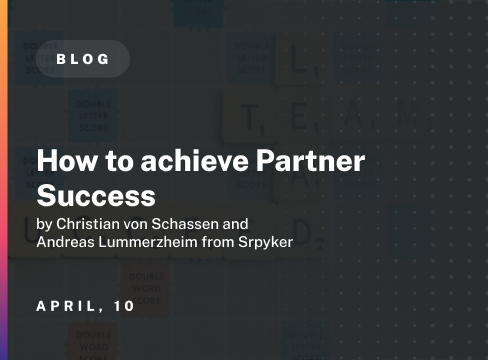Scott Salkin and Asher Mathew, our CEO, recently published an article on Gainsight, explaining their view of achieving customer success through partnerships. When Christian von Schassen and Andreas Lummerzheim founded the Partner Success Management team at Spryker two years ago, this was one of their main goals. In this article they share their experience and also leave their Top 3 Lessons to build Partner Success.
About our authors
Christian is a dad, music-enthusiast, and last but not least a skilled team-builder with over 20 years of experience in the industry, primarily in customer-facing roles. With a broad range of knowledge in software development, digital commerce, and project management, Christian is well-equipped to tackle a variety of challenges faced by growing companies. He is passionate about building empowered, self-sufficient teams that prioritize automation and scalability. Christian’s expertise in these areas enables him to bring structure and vision to his work, helping companies grow and succeed in a competitive marketplace.

Andreas is a highly experienced professional with a background in digital commerce consulting and partner management. He has been with Spryker for over two years, where his main focus is to develop and implement successful partner strategies to achieve mutual growth for Spryker and its partners.

True Partner Success needs a mindset shift and requires hard work
When we founded the Partner Success Management team at Spryker two years ago, achieving customer success through partnerships was one of the two main targets we had in mind. The other was helping our partners achieve success by all means necessary. It was a clear target for us at Spryker to become a partner-first organization.
That wasn’t only for altruistic reasons. One of our core beliefs, backed by years of personal experience in SI organizations, was that partners who deliver well would also have a higher interest in selling. Once they achieve smooth sailing in their projects and have long-standing clients, this becomes a profitable business for them. So helping partners become successful would lead to three results:
- More successful customers who are easier to retain
- More profitable and successful client relations for our partners
- Stronger partnership bonding and more sales success for us
By changing our mindset, we’ve achieved Partnership Success and Through-Partner Customer Success, as Scott and Asher described in their article. But how did we do it?
Building a Partner Success Management practice
During the foundation of the new team at Spryker, we thought about leading principles. They would guide us while building the team and its offerings. One of the tenets was about Scalability and Efficiency. We want to avoid throwing people at challenges. Instead, we aim to develop solutions that allow us to scale without growing the team linearly. We deliberately designed the team to be small and stay small.
To work efficiently, we had to think about automation right from the start. For example, a Partner Portal is critical to offer a one-stop solution for partners to retrieve information without requesting it from us. Automated entry points allow us to create internal tickets, document the requests in our CRM without manual labor, and automatically assign the correct stakeholders. Just like Asher and Scott suggested in the Gainsight-article, we are also looking to incorporate the partner’s view on the joint customer in an automated way. Here as well, the Partner Portal will be crucial to use.
The vital principle of acting efficiently also dictates our thinking when rolling out our new offerings. Our partner organizations are considerably larger than our direct contact base in customer organizations. That means our Customer Success team aims for close relationships with customer stakeholders. In Partner Success, we must devise solutions that address a large group of stakeholders efficiently. That is why one-to-many communication is the standard, and one-to-one communication will be reserved for cases where individual handling makes sense. This is also how we lay out our processes – with the standard one-to-many case in mind. We are trying to minimize exceptions because they require individual solution-finding, which takes time. This thinking has proven very successful by allowing us to roll out offerings and processes for our partners globally continuously.
Another important decision we made early on is that the Partner Success Management (PSM) function is part of the Success rather than the Sales division of Spryker. We already had a well-functioning Partner Sales team handling business development, partner relationships, and marketing. Since then, we have founded Partner Success and later also branched out the marketing part into a dedicated team.

The reason for the Partner Success team to be part of the Customer Success division is mainly the similarities between their functions, especially their targets. While Partner Success Managers have to understand the specifics of a partner organization and the unique needs of partners, the nature of things they have to deal with is often very similar to those of Customer Success Managers. The overlap is significant, and in hindsight, it was an excellent decision to keep both teams close to each other. The collaboration between the Partner Sales and Partner Success Managers is equally essential. Both functions are interdependent, which our section on Lessons Learned will show.
Top 3 Lessons from the experience of building Partner Success
Lesson 1: Connect the dots of your partner journey to create a unique and consistent partner experience
Implementing our Partner Success Team within the Success organization, as described above, has significant benefits for partner and customer success. As expected, completing the triangle between customer, partner, and vendor leads to a rapid decrease in escalations and support cases. We could identify issues earlier and solve them before they got complicated.
On the other hand, this structure resulted in a fragmented partner journey, as a collaboration between partner sales and partner success was not enforced “by design”. Balls got dropped due to unclear responsibilities, communication overlapped, and growing dissatisfaction in the teams were only some of the effects.

The way to solve this was to connect the dots of the partner journey again and align all touchpoints – sales and success – along the lines. This might sound like a no-brainer, but requires lots of effort and management buy-in from both sides.
Aligning all partner efforts in one consistent journey helped bridge the gaps, e.g., between the signing of a new partnership and our activation and onboarding processes, resulting in better partner engagement.
Ultimately, we found a successfully onboarded & trained partner is 70% more likely to close their first deal within the first year, and creates 80% less tickets and development issues within a project. Additionally, we noticed a 9% decrease in lead closing time for partners who successfully ran their sales reps through our sales enablement.
Lesson 2: Delivering true value to your partners brings your relationship to another level
Partner Success Managers extend your contact points in the partner organizations to people like “Head of Delivery”, CTO, and other delivery-related roles. If you succeed in making these your champions, you bring your partner relationship to the next level.
These are the kind of people who can bring valuable feedback about your product, your support team, and many more. Listen to them, and they will happily report from their first-hand experience. Spryker is even in the process of nominating a Partner Delivery Excellence Board to bring more power to these people, helping Partner Success drive the change within Spryker.
Hence our partner-related offerings, e.g. regular Enablement Calls or Beta testing of our new learning platform, saw 20% more attendees providing significantly more feedback across our partner landscape since the introduction of Partner Success Management.
Lesson 3: Partner Success is a success story, but can you prove it?
Measuring partner sales is a well-known terrain based on well-understood metrics. Every C-suite can look at them and immediately understand how successful and valuable their sales team is and how the partners are doing.
Not so much so for Partner Success. Logic and gut feeling speak for a partner success team. Everything feels like improving, but measuring it is another matter. How do you measure your partner success managers’ influence on customer success? How do you prove that better-enabled partners sell more? How do you showcase that your partner ecosystem is “getting better”, and what your role in this improvement is?
We struggled to prove our value proposition to our C-Suite for quite some time, and different-minded managers may have pulled the plug on us.
Metrics were essential to prove the value of partner success to the company. We were able to measure the correlation between the number of sales reps run through our sales onboarding and average lead closing time, for example. Only then did people start to understand what Partner Success could bring to the table.
Besides, these sophisticated partner success metrics provide a more detailed view of your ecosystem’s status quo regarding long-term growth.
From where we are standing, Partner Success truly is a success story. Full stop.
Additional notes:
- You are welcome to connect with Christian and Andreas on LinkedIn – mention Partnership Leaders in your connect invite
Join The 1850+ Leaders Transforming Partnerships
As a member of Partnership Leaders you will:
- Build and learn with the top partner people at the best companies around the world.
- Increase your impact and accelerate your career with proven resources, tools, and best practices.
- Grow a network of peers, partners, and advisors with common objectives.

